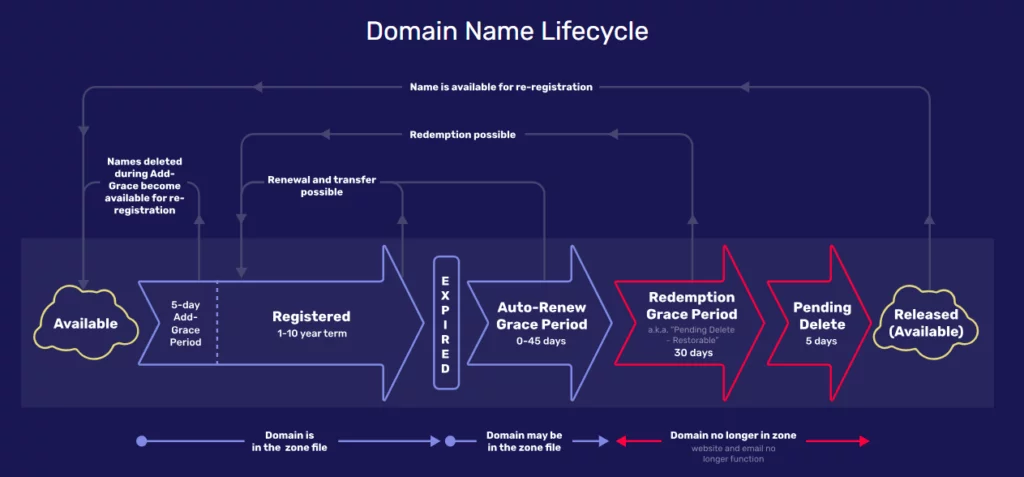How Much Does It Cost to Launch an E-commerce Website in 2024?
- by Ilona K.

Table of contents
Over 2.7 billion people are expected to shop online in 2024. E-commerce sales are booming, offering a flexible and lucrative way to turn your passion into profit. Before diving headfirst into the world of online retail, it's crucial to understand the upfront online business costs involved. We at it.com Domains are keen to empower you with the knowledge needed to make informed decisions about building your online presence.
The global e-commerce market is expected to exceed $6.3 trillion in 2024. Tapping into this lucrative and dynamic market is a no-brainer strategy for a small business aiming to expand its reach and find new customers.
However, starting an e-commerce business comes at a cost. Keen to empower you with the knowledge needed to make informed decisions about building your online presence, we have attempted to break down the basic upfront costs related to setting up your online store.
Starting with Basics
Let’s say you already have a business idea and a business name to sell something online, and have thought through the ways to produce and store your goods. Maybe you already have a physical shop or a pop-up stand where you sell the products to local customers. Your next stop - to start selling online.
Whether it’s a new line of cosmetics, or homemade baked goods, or plant seeds for gardening - the principles of selling online would be the same. You need to make sure your potential customers can:
- Find your product catalogue,
- Order your products and pay for them,
- Choose a delivery option and get them delivered,
- Arrange a return if required.
Broadly, there are two ways you can get this done. You can either launch a store on a third-party retail platform (Amazon, Etsy, Ebay, etc.), or create your own website. We’ll focus on the second option: launching an e-commerce website to sell from it.
Let’s break down a rough estimate of basic upfront costs related to designing, building, and maintaining your first e-commerce website in the U.S. For the purpose of this overview, we have used average market prices valid at the time of publication - those might differ based on where your business is located and which services and specialists you are using.
Please note - this guide won’t cover every single expense you might incur, and rather focuses on the bare minimum required to start an e-commerce business. The cost will also vary based on your business needs, desired level of customization, and chosen platforms.

Step 1: Creating a Website
Your online store is your digital storefront. It's where customers will browse your products, learn about your brand, and ultimately make purchases. Creating a user-friendly and visually appealing website is paramount for success. In order to create your e-commerce website, you can choose one of the options below.
Building on E-commerce Platforms (SaaS)
Platforms like Shopify, BigCommerce, and Wix offer user-friendly interfaces and built-in functionalities for businesses to manage products, inventory, payments, and shipping.
Their biggest advantage is an ease to set up and manage an e-commerce website, even for non-technical users. Many offer free trials and app stores for extending functionalities. On the other hand, customization might be limited compared to other options, and transaction fees may apply depending on the platform.
Cost: Pricing varies depending on the platform and chosen plan. Typically, plans range from $29 to $1000+ per month. The pricier plans often include hosting and additional features.
Hiring Web Designer and Developer
By hiring a web developer and a designer on freelance platforms like Upwork, Freelancer or Fiverr, you can fully customize your online store. This gives you complete control over design, functionality, and scalability for the future growth. However, this option comes with the higher upfront cost compared to other options, and also requires technical expertise to maintain the website once it is built.
In this case, your costs are highly variable depending on the developer's experience, project complexity, and location. Hourly rates typically range from $50 to $200+. Building a complex website can easily cost $5,000 or more.
Using Website Builders
Platforms like Squarespace, Canva, Flazio, Site.pro and Weebly offer drag-and-drop interfaces for building websites without extensive coding knowledge. While not as robust as dedicated e-commerce platforms, they offer basic online store functionalities.
Website builders are often affordable and easy to use. They also come with some basic website templates and design options. However, they have the most limited customization tools out of 3 options reviewed, and their e-commerce functionality might be limited.
Pricing varies depending on the platform and chosen plan. Typically, plans with e-commerce features range from $20 to $40+ per month.

Key Factors Affecting Website Design and Development Costs
- Complexity of the Website: A simple store with a few products will be less expensive to create than a complex website with thousands of products, advanced filtering options, and custom user accounts.
- Number of Products: As the number of products you offer increases, the time it takes to design and populate your website increases as well.
- Level of Customization: Do you want a unique and custom-designed website? Or are you comfortable with a pre-designed template offered by an e-commerce platform? The level of customization significantly impacts the development cost.
- Ongoing Maintenance: Plan to budget for ongoing maintenance, which might include updates, security patches, and bug fixes after the website launches.
Step 2. Choosing a domain name and hosting provider
Some of the platforms above include domain name and website hosting in the pricing plans. However, if you need a bit more flexibility and customization or would like to work with a specific company, your next logical step is to pick a domain name and a hosting provider.
Pro tip: if you found a perfect domain name and don’t want others to take it over while your website is being built, you can get a domain name first and park it. We do not recommend to get your website live on a domain you consider to be a temporary one, as porting your online store to another domain later will incur website migration costs.
Domain name
A right domain name helps customers find your online store - and with the right branding activity, become a valuable asset as your e-commerce business grows. But how much does it cost for a domain name?
The truth is - domain name prices can range from zero (yes, you can find some less popular domain names for free) to $872 million (the cost of cars.com, the most expensive domain name ever sold on the aftermarket).
For the purposes of budgeting - an average domain name cost in the U.S. in 2024 for a small e-commerce business would vary from $10 to $60 per year. However, the actual price of your desired domain name will be affected by:
- Domain zone. For example, domains in the .com top-level domain zone (TLD) - and, most recently, in the .ai TLD - might be more popular than the ones in .biz or .home. Third-level domain zones (such as .it.com) are one way to get highly coveted domain names ending with .com to benefit from the trust users put in them, but also from a wider choice of options.
- Keyword popularity. Common or trendy words and phrases can cost more (sometimes temporary) due to a high interest from businesses. Some popular domains can be considered premium due to coveted keywords and brandability.
- Domain name length. Shorter meaningful domain names are typically pricier than longer names containing multiple words or separated by hyphens.
- Registrar. Different domain name registrars - the companies managing the reservation of Internet domain names - may offer varying prices for the same domain name. We at it.com Domains work with some of the most prominent registrars, such as GoDaddy, ConnectReseller, InternetX, Porkbun and others.
- Add-ons. Extra services like SSL certificates, email hosting, DNS management and protecting your personal data from the public WHOIS database can drive the cost up.
- Renewal. After the first year, you’ll need to renew the ownership of the domain name. The cost of renewing a domain name might be different from the original one, so it’s worth reviewing the costs in the contract. If you don’t renew your registration, the domain name will be released back to the open market.

Hosting an E-commerce Website
Website hosting refers to the service that stores your website files and makes them accessible to users on the internet. Reliable hosting is crucial for ensuring your online store is always online and functioning smoothly.
If you haven’t obtained hosting services through previous steps (whether from an e-commerce platform, or a website builder, or as a part of registering a domain name), here are the main types of hosting options available.
- Shared Hosting ($3-$10 per month): The most affordable option suitable for low-traffic websites. However, your website shares server resources with other websites on the same server, so your performance might be affected by other websites experiencing high traffic.
- Dedicated Hosting ($80-$300+ per month): Dedicated server resources for your website only. Offers improved performance, security and control compared to shared hosting, but comes at a higher cost and requires expertise to manage.
- Cloud Hosting (starts from $10-$50 per month): Flexible hosting solution that utilizes a network of interconnected servers. Offers scalability and reliability to accommodate fluctuating traffic, as the cost depends on usage. However, it cound be more difficult to manage.
Factors Affecting Hosting Costs:
- Storage: The amount of storage required for your website files, images, and videos.
- Bandwidth: The amount of data that can be transferred to and from your website.
- Security: The level of security features and protection required for your website.
- Location of the Server: The location of the hosting server can impact website speed and latency for visitors in different regions.
Step 3: Other Associated Costs
Once your e-commerce website is built, has a domain name and hosting service set up (alongside other crucial elements like SSL certificates etc.), you can technically go live and start selling your products. However, we’d also recommend to factor in some additional upfront costs to start an e-commerce business:
- Payment Processing Fees: Fees charged by payment gateways like PayPal and Stripe, for processing credit card transactions.
- Inventory Costs: Costs associated with purchasing, storing, and managing inventory, including product costs, warehouse fees, and insurance.
- Shipping Costs: Costs for shipping products to customers, including shipping labels, packaging materials, and shipping carrier fees.
- Sales Taxes: Sales taxes that may be applicable depending on your location and the products you sell.
- Content creation: As your website grows, you need to add product descriptions and other relevant content. Some costs can be mitigated using AI tools.
- Marketing and Advertising: Costs for promoting your online store through various channels, such as search engine optimization (SEO), pay-per-click (PPC) advertising, social media marketing, and email marketing. Those can quickly add up depending on how fast you want to scale: for example, a minimum recommended spend on a viable Google Ads campaign is $500-$1000 per month, and on Instagram campaign - at least $5 per day.

To sum up, the cost to start an e-commerce business in 2024 can vary significantly, and this guide covers the bare minimum required. In order to manage upfront costs better, you can:
- Start small: Consider starting with a smaller product range or a basic website to minimize initial costs.
- Utilize free or low-cost tools: There are many budget-friendly solutions available for tasks like email marketing, social media management, and website analytics.
- Negotiate with suppliers: Negotiate with suppliers for better pricing.
- Monitor expenses: Keep track and identify areas where you can cut costs.
- Outsource vs inhouse: If you are skilled in some aspects (e.g. copywriting, managing social media or running digital campaigns), do those in-house to save costs. At the same time, outsource tasks that you are not skilled at or do not have time for.
By carefully considering the costs associated with website design, hosting, domain name registration, and other associated expenses, you can make informed decisions about your budget and resources. Remember, while there are initial costs involved, the potential rewards of running a successful online store can be substantial.
Need tips to run an online business? Visit it.com Domains blog and follow us on social media.

Read also

Tips and Tricks
AI Appreciation Day: Top-10 Domain Names for AI Startups on it.com Domains
- 3 min read

